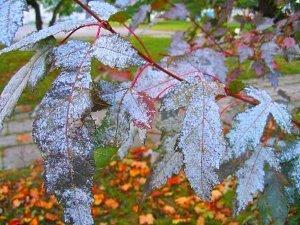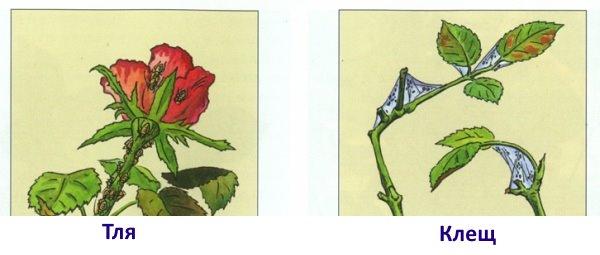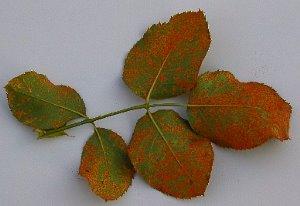Common rose diseases - control methods and disease symptoms
 What usually prevents you from growing healthy flowers? Of course, various diseases and pests. Rose is one of the most sought-after plants among flower growers. Having a "queen of flowers" in your flower bed is considered a symbol of admiration. Diseases and pests in roses can destroy the plant.
What usually prevents you from growing healthy flowers? Of course, various diseases and pests. Rose is one of the most sought-after plants among flower growers. Having a "queen of flowers" in your flower bed is considered a symbol of admiration. Diseases and pests in roses can destroy the plant.
Known rose diseases
Curing roses is an important step in growing a flower. But in order to heal it, knowledge of the varieties of diseases, their symptoms, the causes of their appearance and spread, and methods of struggle are required.
The most famous rose diseases:
- gray rot;
- powdery mildew;
- rust;
- spotting.
To protect roses, it is worth in between flowering. The disinfection process is best done regularly. After all, one disease makes a flower vulnerable to other diseases. Infections quickly spread throughout the plant and cause it to weaken, in the end, it will die. For inexperienced gardeners, it is better to see the most common diseases in roses in pictures. So already a person will have an idea of plant diseases.
How to prevent rose disease?
All diseases of roses must be prevented, for this it is worth carrying out preventive procedures. From improvised means, you can make decoctions of garlic, onions or tobacco, which are sprayed with rose bushes. It is an environmentally friendly method that is not addictive to pathogens.
Chemical treatment is best done in the morning, but not very early, after the dew has melted on the leaves. It is also possible in the evening so that the plant is not already wet. Before processing the flower, you need to water it abundantly at the root.
Diseases of roses and their treatment are a lot of hassle for gardeners. Many people use the tricks of nature.
For example, marigolds or lavender, calendula or nasturtium can be planted next to rose bushes. These plants have a scent that can repel ticks and aphids. Garlic growing nearby helps to prevent fungal diseases.

Preventive measures
The causative agents of the diseases are very persistent, they can live perfectly for a long time on already dead leaves and shoots. Therefore, if the rose was sick, then its remnants, nearby growing weeds and fallen greens should definitely be collected and burned.
Also before preparing for wintering
For prophylaxis in late autumn, it is recommended to process the flower with 3% iron sulfate. At the very beginning of spring - spray the bushes with a solution of copper chloride. Also, do not start work with a pruner or other cutting tool without first treating it with a disinfectant.
It is very important to know how to deal with diseases in roses. Without certain information, the plant will not grow in its favorite area, because each disease does a lot of harm to the flower.
Rust treatment for roses
 Rose rust is easy to spot. Signs of the disease:
Rose rust is easy to spot. Signs of the disease:
- red spots;
- dispute formation.
When and why does rust appear? This is mainly the period of the onset of the first heat. Due to the fact that the plant is very weakened and easily affected by disease.
What to do:
- spraying with a medicinal decoction of horsetail;
- watering with wormwood infusions;
- removal of affected leaves at the initial stage.
Wormwood tincture is prepared in advance so that it is always at hand. 10 liters of water will require half a kilogram of fresh wormwood leaves and 50 grams of dry ones. The infusion should stand for fourteen days. They can be sprayed and watered at the root.
If ordinary decoctions do not help, then treatment with a 1% solution of Bordeaux remedy is required.
Powdery mildew treatment for roses
 Powdery mildew is most often affected by indoor roses or those grown in greenhouse conditions. The disease is not difficult to determine, it appears as a white powder on the flower. After the spores mature, drops begin to stand out, like dew.
Powdery mildew is most often affected by indoor roses or those grown in greenhouse conditions. The disease is not difficult to determine, it appears as a white powder on the flower. After the spores mature, drops begin to stand out, like dew.
At the initial stage of the disease, the white spots are easy to erase, but after a couple of weeks the whole bush will be covered with a "white sore". As a result, leaves and flowers spin and fall off, the plant stem is deformed, young shoots die off. This is the sure death of the rose.
Powdery mildew is difficult to fight, so preventive measures are required: spray the bush with three percent copper sulfate. It is also important not to allow a sharp drop in temperature, which contributes to the spread of the disease.
In the early stages of powdery mildew development, you can treat the plant with an infusion of wood ash and manure. Spray every week.
When the disease is at the stage of moderate severity, it is worth treating the bush once every ten days with a soap-copper solution.
If powdery mildew has already affected most of the rose, then special chemicals will come to the rescue. For example, benomyl or topsin.
Treatment of roses from black spot
 For ground roses, black spot is a great danger. The disease appears if the plant lacks nutrients. Also, waterlogging of the soil contributes to the spread of the disease.
For ground roses, black spot is a great danger. The disease appears if the plant lacks nutrients. Also, waterlogging of the soil contributes to the spread of the disease.
The favorite time for black spot is early summer or late spring. But already visible signs on the plant will appear only in late summer or early autumn.
Symptoms of black spot:
- greens are covered with dark spots;
- a yellow "border" is formed at the ends of the leaves;
- cessation of flower growth.
At the initial stage of the disease, the affected areas of the plant are removed, the bush is sprayed with a decoction of horsetail. If these methods do not help, then the rose is treated with sulfur and honey-containing agents. You can also water at the root with a solution of Bordeaux liquid once a week.
If the above methods of struggle do not help, then it is worth removing the entire bush and burning it. So that black spot does not spread to healthy plants.
Photos of rose diseases can be viewed in the catalogs of specialized stores, and they are also easy to find on the Internet.
No wonder the rose is called the queen of flowers. These are really gorgeous flowers. Every florist dreams of growing beautiful roses. But, unfortunately, there are a number of diseases that have to be dealt with. When growing roses, I most often come across black spot and aphids. If I somehow manage to fight with aphids, then I cannot overcome black spot. I read in the article that you need to water the Bordeaux liquid under the root. I will definitely try. Thanks for the advice.
Tell me, what's wrong with my rose?